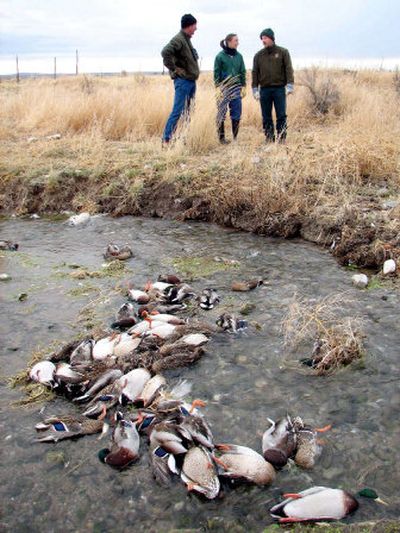Fungus suspected in mallard deaths

BOISE – A fungal infection likely killed 2,500 mallard ducks in a mysterious cluster along a tiny southeastern Idaho creek, a federal wildlife biologist said Friday.
The chances are “extremely high” that Aspergillosis, which can create a fungal toxin on moldy grains and rotting corn, caused the mass die-off, said Paul Slota, a biologist with the U.S. Geological Survey’s National Wildlife Health Center in Madison, Wis.
Aspergillosis will not spread from bird to bird. All the dead mallards probably ate from the same tainted food source, Slota said.
“We’ve seen that before with birds that feed heavily on grains,” he said. “Never in Idaho, but there have been enough reports elsewhere in North America. Aspergillosis die-offs are not a terribly uncommon thing. It happens.”
The Wildlife Health Center has already screened nine intestinal tissue swabs from the dead ducks. Each sample showed fungal plaque in the lungs typical of Aspergillosis and tested negative for avian influenza, Slota said.
Scientists at the Wisconsin laboratory were still testing additional tissue swabs and eight mallard carcasses shipped from Idaho. They were waiting to cross-check their results with tests performed at the U.S. Department of Agriculture’s National Animal Disease Center in Ames, Iowa, before making an official diagnosis.
The testing was expected to rule out all strains of avian influenza virus, including the much-feared H5N1 Asian bird flu, Slota said.
Officials from the Idaho Department of Fish and Game, the U.S. Department of Homeland Security and several other agencies also were awaiting test results on water samples and grain from nearby farm depots that may have become moldy and poisoned the birds.
Farmland surrounds the backwoods creek near the remote town of Oakley, about 180 miles southeast of Boise. A cattle feedlot is close by.
There are no factories in the area that discharge toxins into local streams and rivers. Wastewater does not run into the spring-fed creek, said David Parrish, the regional supervisor for the Idaho Department of Fish and Game.
The ducks began dying last week. On Thursday, state workers cleared the remaining carcasses and brought them to an incineration site.
Parrish said every mallard in a radius of several miles died.
The massive outbreak had puzzled scientists because scavenger birds feeding on the dead ducks were not showing signs of illness.